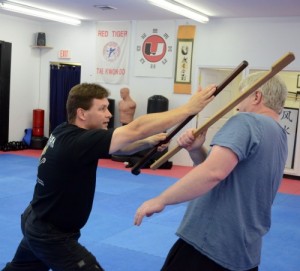Sure, it’s not the same old shillelagh your father brought from Ireland.
Commonly crafted from blackthorn or oak, the shillelagh (from the Irish “sail éille” and pronounced: shuh-LEY-lee) is best known as a simple walking stick, about four feet long, with a large fist-sized knob at the top.
Well, take another look at that blackened, gnarly cane and picture it in the hands of a hard-nosed Irish peasant tasked with defending a moonshine still, or taking offense at a few poorly chosen words at a wake. You can see the potential for some highly creative violence.
Welcome to the world of “bataireacht,” also known as Irish stick fighting—or, more lyrically, whiskey stick dancing. It’s Ireland’s own martial art, hundreds of years old, the lethally balletic techniques passed down from father to son.
Nobody is whacking anyone else over the head with blackthorn sticks any more, but the tradition—in a milder form—lives on here in the Delaware Valley.
Jeff Cavanaugh of Upper Southampton, Bucks County—a multiple black-belt holder and longtime practitioner of the more commonly known martial arts—stumbled upon bataireacht (pronounced “BAHT-air-ahct” three years ago while surfing on the Internet for news and information about martial arts in general. He found a link to the Web site of Glen Doyle, a Milton, Ontario, martial arts instructor. What caught his attention was a reference to Irish stick fighting. It was the first he’d ever heard of it, and right away, he was hooked.
“I contacted Glen and he put me in touch with one of his students, a guy up in Boston named Rob Masson,” Cavanaugh recalls. “I drove up there for a four-hour class, and then back home again. it was Thanksgiving weekend, but the effort was worth it.”
His interest piqued, Cavanaugh asked Masson to come down to Philadelphia to teach a two-day total-immersion seminar for local martial arts aficionados. And after that, he traveled up to Ontario for a weekend workshop with the Celtic sensei himself, Glen Doyle.
Doyle teaches a two-handed style of stick fighting practiced only by his family, going back generations from one Doyle to the next. Until the Doyles came along, most stick fighting was one-handed, the shillelagh wielded like a sword. That style would have been popular among military men. But the Doyles had a different perspective.
“The first Doyles who originated this system were boxers, not people who were experts with swords,” Cavanaugh says. “Their style was developed to fight the single-hand stick fighter. They (the Doyles) just took stick fighting in a different direction.”
The two-handed system, using a shorter three-foot stick held horizontally across the body, allowed for some creative new defensive moves, but it also gave practitioners the flexibility to thrust the stick outward with one hand when needed, like throwing a punch—boxer-style.
Once developed, the Doyle approach became a closely guarded family secret. “It always stayed within the family,” Cavanaugh says. The techniques of Doyle stick fighting made their way to Canada in the 1800s when one of Glen Doyle’s ancestors, Eddy Doyle, migrated to Newfoundland. Over the years, the Doyles continued to maintain the ancient tradition—and their secrets.
That is, until Glen Doyle decided to share his knowledge with any and all interested newcomers.
Cavanaugh continued his relationship with Doyle after that first weekend of teaching and learning. He traveled up to Doyle’s training school several times.
“I was able to pick it up fairly quickly,” Cavanaugh says. “Stick fighting is fairly straightforward. It doesn’t require a lot of strength or flexibility. You have a three-foot stick in your hand, and that’s what makes it so powerful. You’re taking a very heavy stick, and moving it very fast.”
Eventually, Doyle judged Cavanaugh skilled enough to teach. (Cavanaugh, a longtime woodworker, also learned how to create his own fighting sticks.)
And so began Cead Bua Philadelphia, Cavanaugh’s school for Irish stick fighting housed at United Martial Arts in Oreland, Montgomery County. (Cead Bua means “100 victories.”)
For Cavanaugh, who continues to practice the martial arts he grew up with. Irish stick fighting has a very different appeal.
“Having spent years studying martial arts from other cultures, it was great to find something where I could understand the history,” Cavanaugh says. Also when compared to Eastern martial arts, Irish stick fighting was less flashy, more pragmatic.
“Stick fighting is 100 percent useful,” says Cavanaugh. “Stick fighters had a job to do. Anything that didn’t work, they threw away. It was serious business, something that could save your life. You have to accept it on your own terms. There are no high kicks or flashy moves to share with your friends.”
This distinctly Irish martial art does have one thing in common with its ancient Eastern cousins, says Cavanaugh—mental discipline. Also like judo, aikido, tae kwon do and all the rest, the goal of learning it is to never to have to use it. Odds are, no one is going to walk softly through the streets of Philadelphia carrying a big stick, anyway. “The whole idea of getting into an actual stick fight,” Cavanaugh readily concedes with a laugh, “ is pretty far out there.”
Interested in learning more? Cavanaugh is sponsoring an introductory class on Sunday from 1 to 2 p.m., at United Martial Arts, 109 Allison Road (nearest cross street: Bruce Road) in Oreland. Click here for details.

